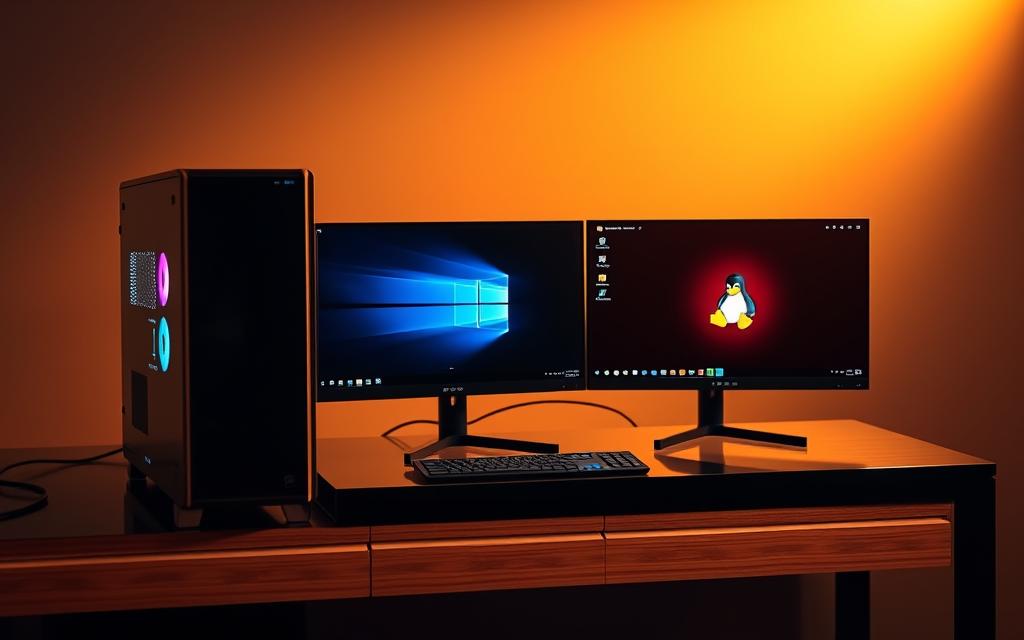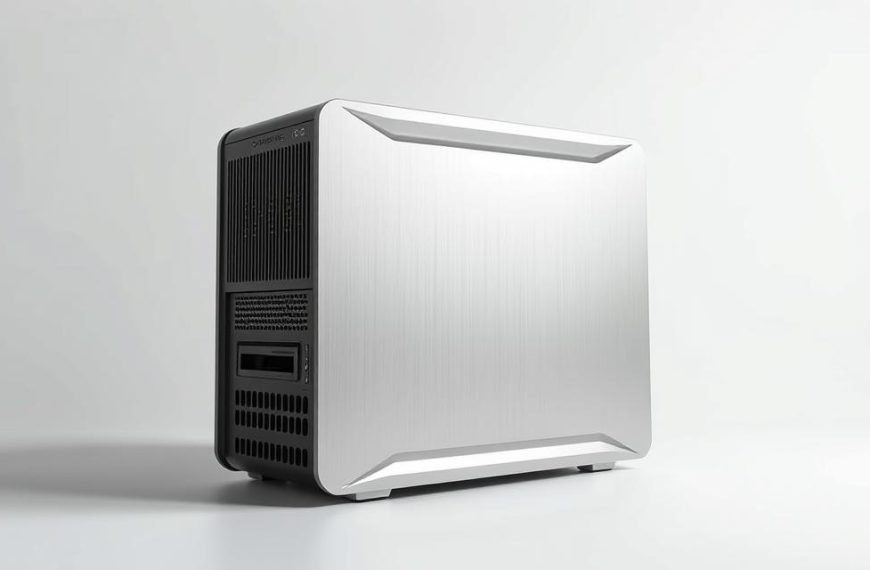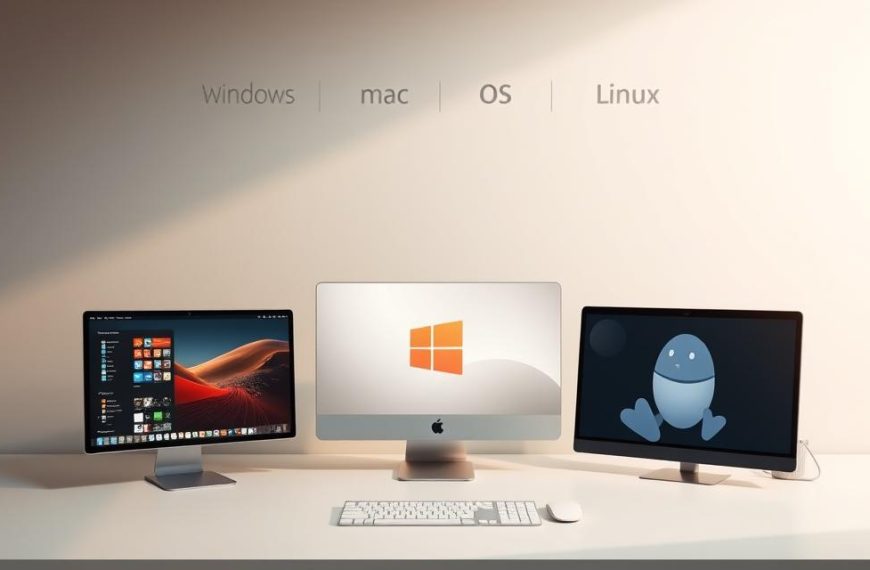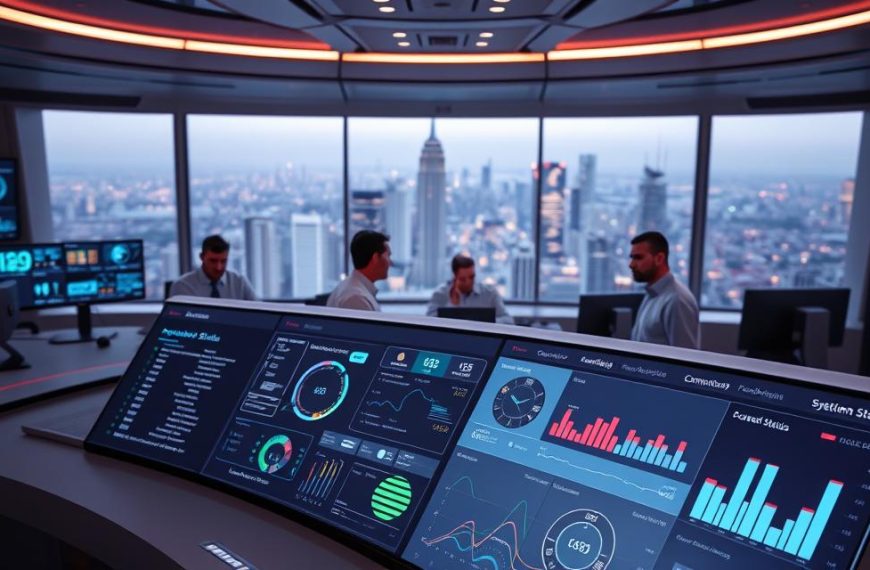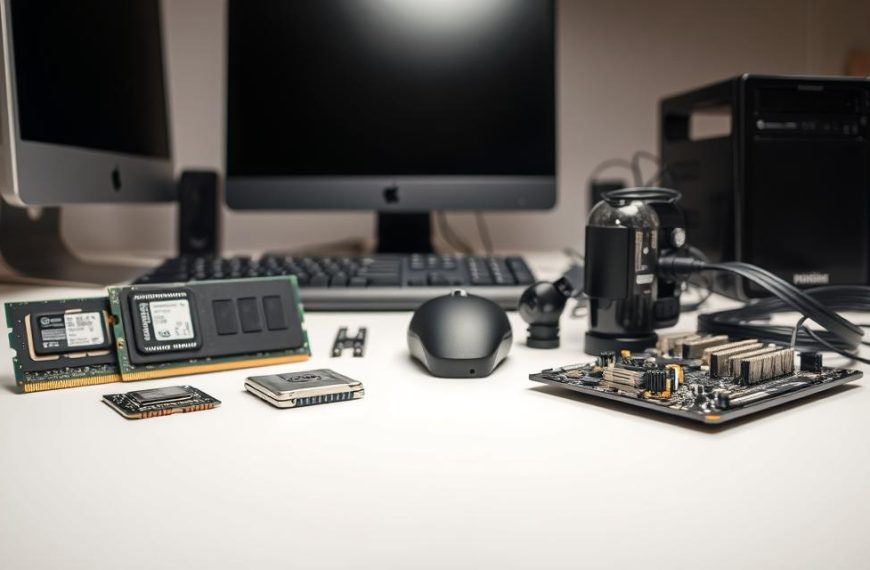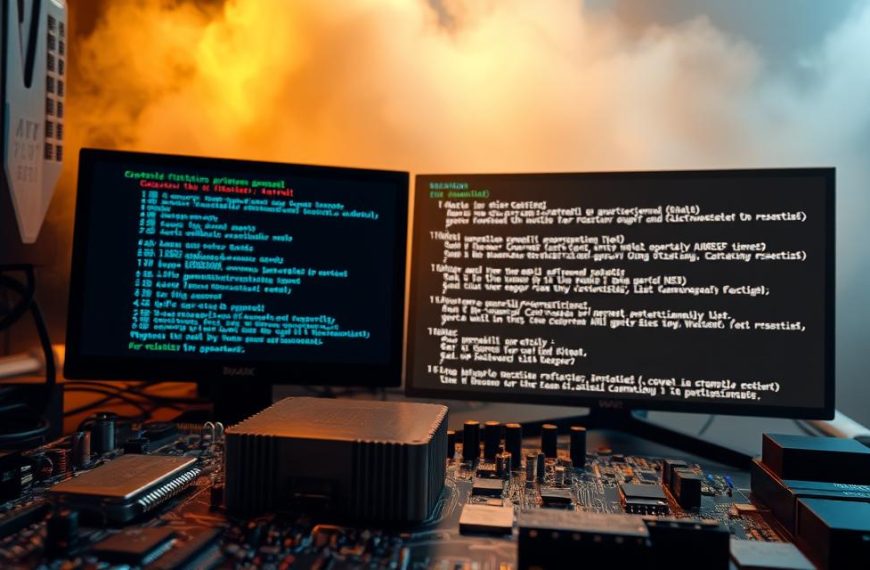Imagine having Windows for work and Linux for projects on one machine. This is possible with dual booting. It lets you pick which system to use when you start your computer.
To dual boot, you create separate areas on your hard drive. Each area runs a different operating system. This way, both systems work well without slowing each other down.
A boot manager is like a menu that shows when you start your computer. It lets you choose which system to use every time you turn it on.
The dual booting benefits are big. You get to use your computer’s full power and keep software working together. You don’t need to have different computers for different tasks.
Our guide will show you how to set up multiple OS on your computer. We’ll cover everything from getting ready to the final steps. It’s all to make sure you can install everything smoothly and successfully.
Understanding Dual Booting and Its Advantages
Dual booting turns one machine into a powerful workstation. It lets you run many operating systems on one computer. This way, you can use the best of each system without needing different machines.
What Dual Booting Means for Your Computing Experience
Dual booting means you have separate areas on your hard drive for different operating systems. You can pick which one to use when you start up. This gives you a clean split between your systems.
This setup keeps your apps and files separate. It makes your computer more stable and organised. You can have your own settings and software for each system.
Key Benefits of Running Multiple Operating Systems
Dual booting brings many benefits beyond just convenience. It makes your computer more productive and fun to use.
Software compatibility is a big plus. Some apps only work on certain systems. Dual booting lets you keep using old software while enjoying new features.
Work environment isolation lets you have different areas for work and play. You might use one system for work and another for gaming. This keeps your activities separate.
Testing capabilities let you try out new systems and software safely. You can test without worrying about messing up your main system.
Common Dual Boot Scenarios and Use Cases
Dual booting is great for many users. It shows how flexible operating systems can be.
Developers often use dual booting. They might use Windows for work and Linux for coding. This way, they can use the best tools for each task.
Some people keep Windows 10 for old programs and test Windows 11 on the same machine. This lets them try new features without giving up their old system.
Creative people use dual booting too. They might have one system for video editing and another for graphic design. This helps them work efficiently with different software.
| Use Case | Primary OS | Secondary OS | Key Benefit |
|---|---|---|---|
| Software Development | Windows 10/11 | Ubuntu Linux | Access to development tools |
| Gaming & Productivity | Windows 11 | Windows 10 | Backward compatibility |
| Creative Work | macOS | Windows 11 | Software availability |
| Testing & Evaluation | Stable OS | Beta OS | Risk-free experimentation |
The table shows how different users benefit from dual booting. Each setup meets specific needs while keeping systems stable and fast.
Dual booting is a smart choice for anyone wanting to get the most from their computer. It’s a way to boost your machine’s power without buying new hardware.
Essential Preparation Before You Begin
Before starting the dual boot installation, it’s vital to prepare well. Setting up your system right and backing up your data can avoid problems. This makes the installation smoother.
Backing Up Your Critical Data
One big risk is losing data when changing your system’s boot settings. Start by making detailed backups. This is key in the data backup for dual boot process.
Creating Complete System Backups
Use tools like Macrium Reflect or Acronis True Image for full system images. They capture your whole system, including programs and settings.
This backup lets you go back to how your computer was before if issues arise during setup.
Important Files and Documents to Secure
Don’t just focus on system images. Also, protect your personal files. Key items to back up include:
- Documents, spreadsheets, and presentations
- Photos, videos, and other media collections
- Browser bookmarks and saved passwords
- Email archives and contact lists
- Application settings and license keys
Keep these backups safe on external drives, network storage, or in the cloud.
System Requirements and Compatibility Checks
Do a system compatibility check to make sure your hardware can handle multiple operating systems. Check if your computer meets the minimum needs for both systems.
Look at:
- Storage space for new partitions
- RAM for running both systems well
- Processor match with your target OS
- Graphics card drivers
- UEFI/BIOS version and settings
Check the official documentation for each OS to confirm hardware needs before you start.
Gathering Necessary Installation Media
Getting the right installation files is also key. Always get OS images from official sources for security and compatibility.
For Windows, get ISO files from Microsoft’s site. For Linux, use the project’s main site or trusted mirrors. The installation ISO download involves:
- Visit the official distribution website
- Pick the right version and architecture
- Check download checksums for integrity
- Make bootable USB media with tools like Rufus or Etcher
Make sure you have a stable internet connection for downloading large ISO files. These can be 2GB to 5GB, depending on the OS.
While preparation takes time, it greatly lowers risks and troubleshooting later in the dual boot process.
Partitioning Your Hard Drive for Dual Booting
Before you install a second operating system, you need to make space on your hard drive. This means dividing your drive into sections, each for a different OS. Proper hard drive partitioning helps everything run smoothly and avoids data problems between systems.
Understanding Disk Partitioning Concepts
Partitioning splits your physical storage into logical parts. Each part is like a separate unit with its own files. This is key for keeping systems separate when you have more than one.
Primary vs Extended Partitions
Older hard drives can have up to four primary partitions. These are where you can put operating systems. If you need more, you have to use an extended partition.
Extended partitions hold logical drives. They don’t store data but let you have more than four partitions. Most systems today use GPT partitioning, which doesn’t have these limits.
Recommended Partition Sizes for Different OS
Having enough space is important for performance. Here are some partition size recommendations:
- Windows 10/11: At least 50GB for system files, plus more for apps and updates
- Linux distributions: 20-30GB for system files, with extra for home directories
- macOS: At least 40GB, but 60GB is better for flexibility
Remember to add extra space for updates and personal files. Doubling the minimum is a good rule for comfort.
Using Windows Disk Management Tools
Windows has tools for basic disk management. The Disk Management utility lets you shrink and create partitions without extra software.
To use it, right-click the Start menu and choose “Disk Management”. Here, you can:
- Shrink your main partition to free up space
- Create new partitions from unallocated space
- Format partitions with the right file systems
- Assign drive letters to new partitions
This method is good for simple needs but might not work for complex setups.
Third-Party Partitioning Software Options
For more complex hard drive partitioning, third-party tools are better. They offer more features than Windows’ built-in tools.
Some popular choices are:
- GParted: Free, open-source, great for Linux
- AOMEI Partition Assistant: Easy to use, has lots of features
- EaseUS Partition Master: Powerful, includes recovery options
These tools often have backup features and can resize partitions safely. They’re great for working with different operating systems.
Always back up your data before using partitioning software. Even though these tools are reliable, problems can happen during the process.
How to Run Two Operating Systems on One Computer
Now that your hard drive is set up, you can install your second operating system. This can be Windows or Linux. Follow these steps carefully for a smooth setup.
Installing Windows Alongside Another Windows Version
Adding a second Windows needs care to avoid losing your current system. This guide is for Windows 10 and 11 users.
Step-by-Step Installation Process
Start by putting in your bootable USB or DVD. Restart and choose to boot from it. You might need to change BIOS/UEFI settings first.
When Windows starts, pick your language and click “Install Now.” Don’t enter a product key yet. Accept the terms and choose “Custom: Install Windows only (advanced)” to avoid overwriting your current system.
Critical step: Pick “Custom: Install Windows only (advanced)” to install alongside, not replace, your current Windows.
Choose the unallocated space you made earlier for the new Windows. The installer should keep both systems.
Configuration Settings and Best Practices
During setup, set your region, keyboard, and user accounts. Make a new user for the new Windows to keep things separate.
After setup, your system will restart in the new Windows. Finish the initial setup, including privacy and Cortana settings if you want.
Install essential drivers right away. Windows Update will cover most, but check the manufacturer’s site for graphics and other drivers.
Potential Pitfalls and How to Avoid Them
The biggest risk is picking the wrong partition. Double-check you’re installing to the right space, not your main Windows.
Boot loader conflicts can happen. If your original Windows isn’t in the boot menu, use recovery tools to fix it.
Driver issues can pop up between Windows versions. Always get drivers for your specific version, not generic ones.
Adding Linux to a Windows System
Linux works well with Windows, thanks to modern tools. Adding Linux to Windows is now easier than ever.
Distribution Selection and Preparation
Go for a user-friendly Linux like Ubuntu, Linux Mint, or Fedora. They have easy installers that find your Windows.
Download your Linux ISO from its official site. Make bootable media with Rufus or Etcher. Turn off Windows Fast Startup and Secure Boot in BIOS/UEFI settings before you start.
Dual Boot Installation Procedure
Boot from your Linux media. Most distributions have an “Install alongside Windows” option that handles everything.
If you want to do it manually, choose “Something else.” Set up your partitions: root (/), swap, and /home if you have separate ones.
The installer will set up GRUB. This will let you choose between Linux and Windows at startup.
Post-Installation Configuration Steps
After installing, boot into Linux. Update your system with the package manager (apt update && apt upgrade on Ubuntu-based systems).
Install drivers through your distribution’s manager. Many offer proprietary drivers for better graphics performance.
Install multimedia codecs for media compatibility. Most distributions have a single command or package (ubuntu-restricted-extras on Ubuntu) for this.
Customise your boot loader if you want. You can change the default OS, timeout, and menu look through GRUB tools.
Configuring Your Bootloader
After installing your second operating system, the bootloader lets you choose which OS to start. It’s key software that manages your computer’s startup. It shows you options every time you turn it on.
Understanding GRUB and Windows Boot Manager
Two main bootloaders are used in dual boot setups. The Windows Boot Manager handles multiple Windows installations. It comes with Windows and shows up when you install different versions.
The GRUB bootloader (Grand Unified Bootloader) is common in Linux. GRUB finds other operating systems, including Windows. It has a flexible menu with more options than Windows’ bootloader.
Customising Boot Options and Default OS
Most people want their main OS to start automatically. Both bootloaders let you change the default OS. You can set a timeout for the menu before it boots automatically.
GRUB users edit /etc/default/grub to change the default OS. The TIMEOUT setting controls the menu’s duration before it boots automatically.
Windows Boot Manager settings are changed through System Configuration (msconfig) or Command Prompt. These tools let you adjust the boot order and timeout through a graphical interface or commands.
Troubleshooting Common Boot Issues
Dual boot troubleshooting is needed when things don’t work as expected. A common problem is when an OS doesn’t show in the boot menu. This usually happens when the bootloader can’t find the installation.
If you’re always booting into one OS without seeing the menu, check your UEFI/BIOS settings. Make sure fast startup is off in Windows. This feature can mess with the bootloader.
For missing entries, boot repair tools can fix the boot configuration. Windows users can use the Installation Media’s Repair option. Linux users often use boot-repair tools from a live USB.
Be careful with system updates to keep your bootloader working. Big updates can change your boot settings. You might need to rebuild your boot menu after an update.
Maintaining Your Dual Boot System
Once your dual boot setup is working, you need to keep it running smoothly. This means looking after both operating systems well. It also means keeping your data safe across different parts of your hard drive.
Regular System Updates and Compatibility
It’s key to update both operating systems regularly. This keeps them secure and adds new features. Each system needs its own updates.
Try to update when you’re not using your computer. This stops any problems. Sometimes, big updates can change how your computer starts up. So, always save a copy of your system before you update.
Managing OS updates well means checking drivers. Drivers for graphics and chipsets need to match between systems. This keeps everything running smoothly.
Managing Disk Space Between Operating Systems
Keeping an eye on disk space is important in dual boot setups. Both systems need room for files, apps, and to grow.
Here are some tips for managing disk space:
- Check disk usage every month with tools
- Use shared storage for files you need on both systems
- Set up alerts for when disk space is low
- Clear out temporary files and unused apps regularly
The table below shows how much free space you should have for different types of partitions:
| Partition Type | Minimum Free Space | Recommended Free Space | Critical Threshold |
|---|---|---|---|
| System Partition | 15 GB | 25 GB | 5 GB |
| Data Partition | 10% of total | 20% of total | 5% of total |
| Shared Storage | 5 GB | 15 GB | 2 GB |
Security Considerations for Dual Boot Setups
Dual boot security is vital. A problem in one system could harm files in the other. You need to protect both.
Here are some key security steps:
- Use good antivirus software on both systems
- Turn on firewalls for each system
- Use full-disk encryption if you can
- Keep all security software up to date
Make separate user accounts with strong passwords for each system. This helps keep things separate and safe.
Run security scans often to find and fix problems. Do a full scan every week. This keeps your dual boot security strong.
Conclusion
Setting up a dual boot system gives you the flexibility to use different operating systems on one machine. You can run Windows, macOS, and Linux, each with its own software. This way, you get the best performance from each system.
Getting ready is key to a successful setup. Make sure to back up important files and check your hardware works well. Also, divide your storage carefully to avoid problems. These steps help your systems work smoothly together.
Our guide to running multiple operating systems explains the technical side of setting it up. It shows how to create a flexible computer environment for all your needs.
This guide proves that with the right planning, you can use different platforms without losing performance or stability. You get a computer that fits your exact needs.
Learning to set up multiple operating systems lets you get the most out of your hardware. You can enjoy the top features of each system. Your dual boot machine is the ultimate in flexible computing.

